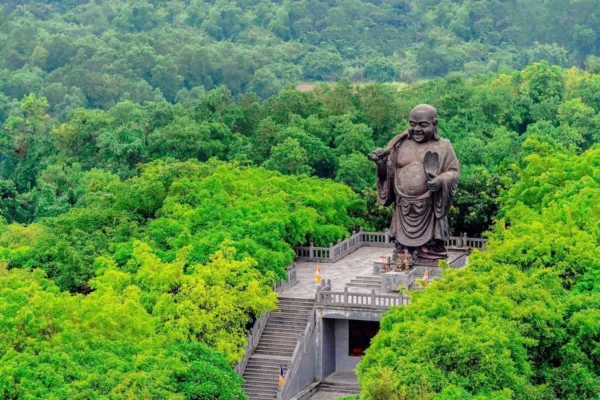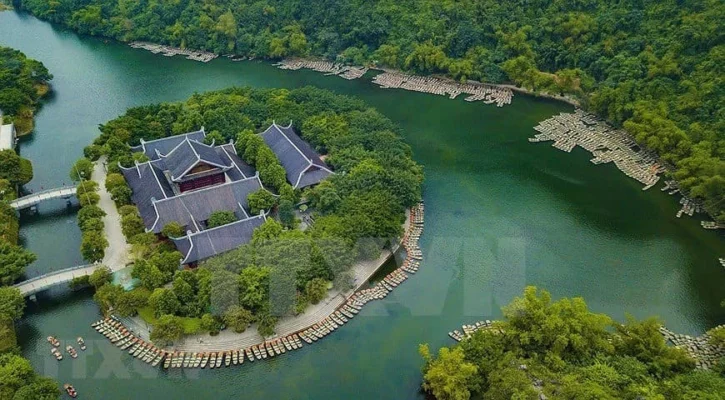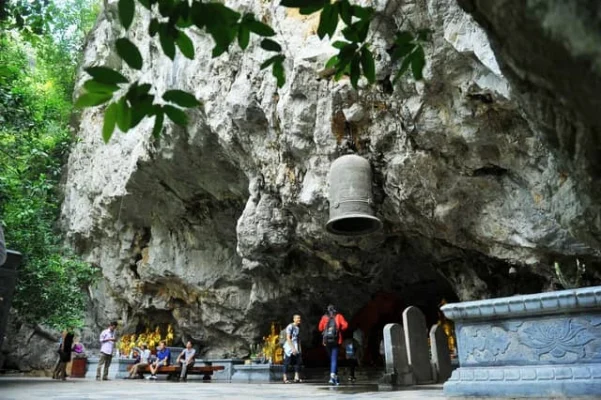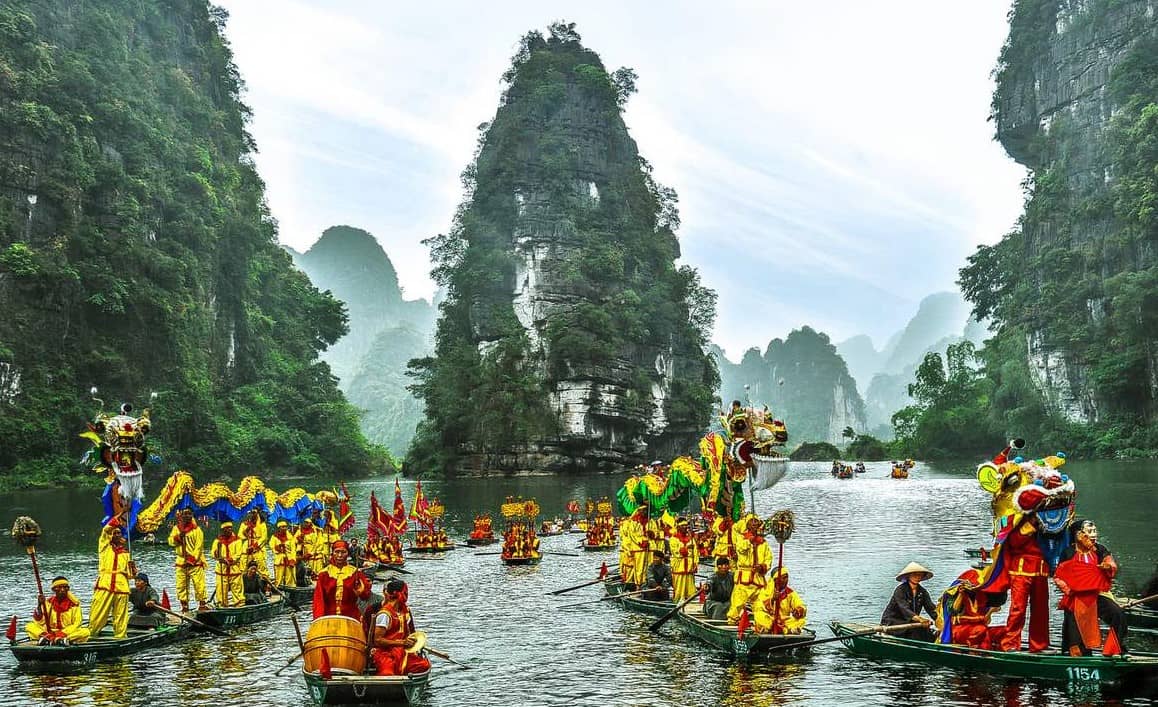
Let’s explore one of the largest temples in Vietnam.
Explore Bai Dinh Pagoda-the largest pagoda complex in Vietnam in Ninh Binh. Admire the unique architecture, giant Buddha statue, the longest La Han corridor and participate in traditional Buddhist rituals. Detailed guide on history, how to get there, and interesting experiences when visiting. Follow Ula Travel to find out now!
I. Overview of Bai Dinh Pagoda
1. Where is Bai Dinh Pagoda?
Bai Dinh Pagoda is located in Gia Sinh commune, Gia Vien district, Ninh Binh province, Vietnam. About 15 km northwest of Ninh Binh city center, the pagoda is located in the Trang An scenic complex, a UNESCO World Cultural and Natural Heritage.
2. Cultural role of Bai Dinh pagoda
Bai Dinh Pagoda is not only one of the largest pagodas in Vietnam but also stands out with notable records such as the largest bronze Buddha statue in Southeast Asia, the longest Arhat corridor in Asia, and many valuable Buddhist treasures.
The pagoda is the place where major Buddhist events take place, attracting thousands of followers and visitors from all over the world every year, especially during the spring festival season. With its profound cultural and spiritual significance, Bai Dinh Pagoda plays an important role in the spiritual life of the Vietnamese people and is a symbol of Buddhism in Vietnam.
3. Why should you visit Bai Dinh Pagoda?
Bai Dinh Pagoda is an ideal destination for those who want to seek serenity and immerse themselves in the quiet space of a Zen monastery. Visitors will admire the unique architecture that combines tradition and modernity. The new pagoda, with its large scale, includes many impressive structures such as the giant Maitreya Buddha statue, the towering bell tower, and solemn shrines.
II. History and origin of Bai Dinh Pagoda
1. History of Bai Dinh Pagoda

Bai Dinh ancient pagoda has a history spanning thousands of years.
More than 1000 years ago, the three feudal dynasties of Dinh, Tien Le, and Ly were very interested in and considered Buddhism to be the national religion, so they built many ancient pagodas, including the Bai Dinh Pagoda located in the Trang An mountain range. The pagoda was established during the Dinh dynasty but still has many architectural details and antiques bearing the strong imprint of the Ly dynasty.
In 1997, Bai Dinh Pagoda was recognized as a national historical, cultural, and revolutionary relic. With such special and sacred things, the pagoda welcomes a large number of tourists and Buddhists every year. If you have the chance, come and experience this land of talented people.
2. Religious and cultural significance

Bai Dinh Pagoda is a symbol of the development of Buddhism in Vietnam.
Bai Dinh Pagoda has a special place in the history of Vietnamese Buddhism. This place is not only a famous pilgrimage site but also a symbol of the intersection between Buddhist beliefs and indigenous beliefs. Bai Dinh Pagoda is also the place where many important Buddhist rituals take place, attracting a large number of Buddhists and tourists from all over the world.
III. Architecture and Scale of Bai Dinh Pagoda
Bai Dinh Pagoda is a large spiritual complex including both ancient and new pagodas, demonstrating the subtle combination of Vietnamese Buddhist traditions and modern architecture.
1. Ancient Bai Dinh Pagoda

Ancient Bai Dinh Pagoda
The original pagoda is about 800 meters away from the modern one on the foothills. The walkway rises over 300 stone steps before passing beneath an impressive gate to reach the entryway. The original pagoda is nestled amid numerous little caves on the mountainside. Mountain spirits, like Buddhist deities, are venerated here.
Outstanding landmarks.
- The Bell Tower is an octagonal-shaped tower with three levels of varied sizes. The base has a diameter of 17 meters. The tower stands 18.25 meters tall, supported by a lotus-shaped platform. Inside is a 36-ton bronze bell.
- The hallway with Arhat sculptures is Asia’s longest corridor, with 500 Arhat statues on each side.
- Gieng Ngoc (The Pearl Well): This moon-shaped well was built approximately 1,000 years ago. The diameter is 30 meters, and the depth is ten meters.
- The Hall of Bodhisattva Avalokitesvara: This seven-compartment ironwood structure stands 14.8 meters tall, 40.4 meters long, and 16.8 meters wide. Inside is an 80-ton bronze statue of Bodhisattva Avalokitesvara, decorated with gold eyes and hands.
- Bao Thap Tower, a 99-meter-tall, 13-story building with 72 stair steps, houses ancient Buddha relics from India and Burma.
- The Maitreya monument is a 10-meter-tall bronze monument placed on the tallest slope of Bai Dinh Pagoda. Weighing 80 tons, it is Southeast Asia’s largest outdoor bronze Maitreya statue.
Start your journey with Ninh Binh Tour in 2 Days.
2. New Bai Dinh Pagoda

New Bai Dinh Pagoda
The 80-hectare rebuilt Bai Dinh Pagoda is located on Ba Rau Hill, near the Hoang Long River. This is a huge complex with several buildings constructed between 2003 and 2010. The new pagoda’s architecture includes large rooms, gardens, and enclosures.
Bai Dinh Pagoda stands out from other Vietnamese Buddhist pagodas due to its great size. Tam The Hall, the greatest structure here, is 34 meters tall and more than 59 meters long. The building materials are Ninh Binh stone and lumber, as well as Bat Trang Village tiles.
The pagoda’s curled finials and soaring corner eaves, which resemble a phoenix tail, are reminiscent of traditional Vietnamese architecture. The interior features materials sourced from traditional Vietnamese craft towns. These include Y Yen’s bronze sculptures, Ninh Van’s stone carvings, Phu Loc’s woodwork, and Ninh Hai’s embroidery.
IV. Experiences and activities at Bai Dinh Pagoda
1. Architecture tour

The unique architecture of the temple attracts tourists.
Bai Dinh Pagoda is a massive architectural complex, combining traditional and modern features. When visiting, visitors have the opportunity to explore many outstanding structures, including:
- Tam The Temple is the largest main temple, with three bronze Buddha statues 7.2 m high, symbolizing the past, present, and future.
- Dharma Lord Temple: The place where the largest bronze statue of Buddha Shakyamuni in Vietnam, weighing 100 tons, is located.
- Arhat corridor: More than 3 km long, with 500 Arhat statues made of green stone, each statue has a different appearance and expression, bringing a sense of sacredness and mystery.
Do not miss: Ninh Binh to Halong Bay – Heritage Road Journey 4D3N
2. La Han Corridor

La Han Corridor
One of the famous spaces of Bai Dinh Pagoda is the La Han Corridor with a length of up to 3km. The corridor is made of wood, consisting of 2 rows with 234 compartments with a length and width of 4.5m.
Along both corridors of the pagoda are 500 La Han statues sculpted by the most famous artisans of Ninh Van craft village. These 500 La Han statues have different shapes, moods, and demeanors, expressing the harmony between the emotions of the missionary. Each statue is up to 2.5m high and is crafted with great care and sophistication.
3. The largest bronze Buddha statue in Southeast Asia

The largest bronze Maitreya Buddha statue in Southeast Asia.
Bai Dinh Pagoda is famous for its 10-meter-high, 100-ton statue of Buddha Shakyamuni, cast entirely of pure bronze. This is the largest bronze Buddha statue in Southeast Asia, attracting the attention of visitors thanks to its majesty and symbol of enlightenment.
You will be like: Hanoi to Ninh Binh in 3 Days
4. Giant Bell Tower

Giant Bell Tower
When you come to Bai Dinh Pagoda, you should visit the bell tower area, where the Great Bell and the largest bronze drum in Vietnam are kept. The tower is designed like a lotus flower with 3 floors gradually widening from top to bottom.
Each floor of the tower will include 16 columns, including 8 main columns and 8 small columns with an average height of 8m. It can be said that the bell tower is a symbol of the eternal existence of the nation. The tower will be hung with a bronze bell weighing 36 tons. Inside the tower there is a staircase leading up so you can walk around to see the bell more clearly.
Click here: Northern Vietnam Itinerary
5. Quan Am Temple

Quan Am Temple
The Quan Am Temple of Bai Dinh Pagoda is the place to worship Bodhisattva Avalokitesvara. The temple has a unique architectural style with many elaborately arranged pillars and columns. The special feature of the temple is that it has 2 floors, 8 roofs and 32 columns with a height of up to 11.8m.
Each pillar of the temple is located on a square stone in the shape of a lotus flower. All these details have created a new and unique architectural style of the temple.
6. Bao Thap Tower

Bao Thap Tower
Bai Dinh Pagoda has long been famous for its Bao Thap Tower bearing the glorious mark of the Ly Dynasty Buddhism period. The tower is decorated with many impressive patterns and motifs such as lotus petals, clouds, bodhi leaves, etc. In particular, the entire tower is made of terracotta bricks originating from Bat Trang pottery village.
The Bao Thap Tower is considered a typical symbol representing the cultural life of the Vietnamese people. When entering the tower, you will be surprised by the extremely sacred but equally splendid space. In the main hall of the tower, the statue of Buddha Shakyamuni is respectfully placed on a three-tiered altar, showing the solemnity of this place.
Let’s Discover Ninh Binh Day Trip from Hanoi for Best Experiences!
7. Bai Dinh Pagoda Festival

Bai Dinh Pagoda Festival
Every year, Bai Dinh Pagoda will hold a festival to commemorate the great contributions of the generals and heroes who sacrificed for the country. The festival takes place from the afternoon of the first day of Tet and lasts until the end of March. For the Bai Dinh Pagoda Festival, the festival will officially open on the 6th so that visitors can make a pilgrimage to pray for a favorable year and remember the ancients.
V. Useful Information for Visitors
1. How to Get There From Hanoi
Located about 95 km from Hanoi, 15 km from Ninh Binh city and 7 km from Hoa Lu ancient capital, visitors can easily choose many means of transportation to the pagoda such as bus, motorbike and car. It takes about two hours to travel by private car or tourist bus.
2. Best Time to Visit
- Spring (between January and March of the lunar calendar) is the best time to visit Bai Dinh Pagoda with its cool and pleasant climate and many festivals taking place. This is the perfect opportunity to experience the culture and learn about this special pagoda
- However, spring is the busiest tourist season, and many places are overcrowded. As a result, if you dislike crowds, you should visit at a different time.
3. Ticket Prices
The Bai Dinh Pagoda is open daily from 6:00 AM to 10:00 PM.
- Bai Dinh Pagoda admission charge is free.
- Electric car: 60,000 VND/person/trip; operates till 8:00 PM.
- Ticket to Bao Thap Tower costs 50,000 VND per person.
- Parking: 40,000 VND for cars and 15,000 VND for motorcycles.
VI. Notes when visiting Bai Dinh Pagoda
1. What to wear when visiting Bai Dinh Pagoda?
When visiting Bai Dinh Pagoda in Ninh Binh, you should wear polite clothes because this is a solemn and sacred place. Visitors can choose simple clothes such as long-sleeved shirts, long skirts or pants. Besides, you should also bring a jacket and hat to visit the temple grounds because it is quite sunny in the summer.
In particular, the temple is quite large, so you can bring sneakers or soft sandals to avoid foot pain when visiting. In winter, the air in the North is often quite cold, so visitors need to dress warmly.
2. Respect the culture
- Attitude and behavior: Avoid laughing and talking too loudly in solemn places where incense is burned.
- Respect culture: Learn about the culture and the correct way to burn incense. Follow the tour guide or ask the locals.
3. Taking photos
- Permitted areas: Some areas in the temple may prohibit photography, especially in the main shrines. Pay attention to the signs and ask the staff if you are unsure.
- Use of flash: Avoid using flash when taking photos, especially in worship areas so as not to affect the solemn space.
VII. Tourist Attractions Near Bai Dinh Pagoda
1. Trang An Scenic Landscape Complex

Trang An Scenic Landscape Complex
Trang An Scenic Landscape Complex is one of the UNESCO-recognized world heritage sites. This is an area notable for its system of caves, valleys, and lakes, which create a majestic and poetic natural landscape. Highlights:
- Boat Tour: Boat tours usually last from 2 to 4 hours. Visitors will relax on a boat passing through beautiful limestone mountains, explore mysterious caves and admire the impressive scenery of Trang An.
- Natural landscape: lush vegetation, limestone mountains, and cultural relics blend together in a wonderful landscape painting.
2. Hoa Lu Ancient Capital

Hoa Lu Ancient Capital
As the first capital of Dai Co Viet under the Dinh and Tien Le dynasties, Hoa Lu Ancient Capital preserves many important historical relics such as the temples of King Dinh Tien Hoang and King Le Dai Hanh. This area was carefully selected according to feng shui with limestone mountains resembling walls protecting the capital. Visitors coming here will be able to admire ancient architecture and learn about the golden age in Vietnam’s feudal history.
3. Am Tien Cave (Tuyet Tinh Coc)

Am Tien Cave
Am Tien Cave, also known as “Tuyet Tinh Coc”, is a green valley with a clear lake isolated from the outside. This place has a peaceful landscape and was once the place where Queen Duong Van Nga practiced asceticism. When coming here, visitors feel like they are lost in a fairyland with beautiful scenery and return to the past when learning about the remaining relics.
4. Thung Nham Bird Park

Thung Nham Ecotourism Area
Thung Nham Bird Park is a famous ecotourism area with pristine natural scenery, especially the flooded forest area with thousands of bird species. Visitors can take a boat to sightsee, admire rare birds, and explore natural caves such as Hang But and Hang Nuoc. Thung Nham offers a peaceful experience and closeness to nature.
Learn more about: Best things to do in Ninh Binh
5. Mua Cave

Mua Cave
Mua Cave is famous for its stunning scenery when climbing to the top of the mountain, where you can see the whole Tam Coc area with rice fields and winding rivers. The journey up 500 stone steps to the top of the mountain is challenging but well worth it for the majestic view. This is one of the outstanding photography locations that visitors should not miss when coming to Ninh Binh.
In conclusion, Bai Dinh Pagoda is a cultural and religious heritage of Vietnam. With its oriental Buddhist architecture and impressive structures, Bai Dinh Pagoda has a majestic and splendid beauty that attracts visitors from all over the world to admire. Coming here, visitors will be able to admire Buddhist architectural works like works of art and immerse themselves in the sacred, quiet space. Visitors can not only visit but also learn about Buddhist beliefs as well as the spiritual culture of life in Vietnam. Prepare and get ready for a trip to Bai Dinh Pagoda today!
See more: Ninh Binh travel tips


























